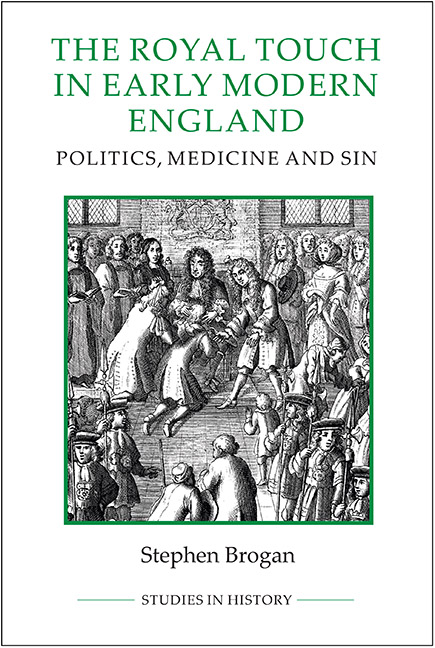Book contents
- Frontmatter
- Contents
- List of Illustrations
- List of Tables
- Dedication
- Acknowledgements
- Abbreviations
- Introduction
- 1 The origins and medieval history of the royal touch, 1000–1485
- 2 The Tudors: revival and reform of royal therapeutics, 1485–1603
- 3 The royal touch and the Stuart monarchy, 1603–1688
- 4 The ritual process of the royal touch, 1660–1688
- 5 The Restoration debate: the rise of ambivalence and scepticism, 1660–1688
- 6 The royal touch and the early English Enlightenment, 1689–1750
- Conclusion
- Bibliography
- Index
- Frontmatter
- Contents
- List of Illustrations
- List of Tables
- Dedication
- Acknowledgements
- Abbreviations
- Introduction
- 1 The origins and medieval history of the royal touch, 1000–1485
- 2 The Tudors: revival and reform of royal therapeutics, 1485–1603
- 3 The royal touch and the Stuart monarchy, 1603–1688
- 4 The ritual process of the royal touch, 1660–1688
- 5 The Restoration debate: the rise of ambivalence and scepticism, 1660–1688
- 6 The royal touch and the early English Enlightenment, 1689–1750
- Conclusion
- Bibliography
- Index
Summary
‘Saturday being appointed by his Majesty to touch such as were troubled with the Evil, a great company of poor afflicted Creatures were met together, many brought in Chairs and Flaskets, and being appointed by his Majesty to repair to the Banqueting house, his Majesty sat in a Chair of State, where he strok’d all that were brought to him, and then put about each of their Necks a white Ribbin with an Angel of Gold on it. In this manner his Majesty strok’d about 600, and such was his princely patience and tenderness to the poor afflicted Creatures that though it took up a very long time, his Majesty being never weary of wel-doing, was pleased to make enquiry whether there were any more that had not yet been touch’d. After Prayers were ended, the Duke of Buckingham brought a towel and the Earl of Pembrook a Basin and Ewer, who after they had made their obeisance to his majesty, kneeled down till his Majesty had washed’
Mercurius Publicus, 21–28 June 1660As soon as Charles II was restored to the throne at the end of May 1660 he began to hold public ceremonies at least twice a week in London at which he touched between 200 and 600 people who were ill with scrofula. This disease was also known as struma, or the king's evil (‘evil’ as in malady, the king's as he was thought to be able to cure it) or, as in the newspaper extract, it was sometimes just called ‘the evil’. It is an infection of the lymph nodes by the tubercular bacillus, known in the modern world as tubercular adenitis; its symptoms include painful and disfiguring abscesses and suppurations on the face and neck.
The ceremonies performed by Charles II were structured around prayers and passages from the New Testament, following a practice that had existed in different forms in England and France since the early Middle Ages. The purpose of these services was to cure the sick in an imitation of Christ, whom the Gospels recorded as having healed numerous people by his touch, including those who were blind or had leprosy, or were physically infirm. Just as Christ's cures were described as miraculous, so were those attributed to the royal touch.
- Type
- Chapter
- Information
- The Royal Touch in Early Modern EnglandPolitics, Medicine and Sin, pp. 1 - 22Publisher: Boydell & BrewerPrint publication year: 2015
- 1
- Cited by



